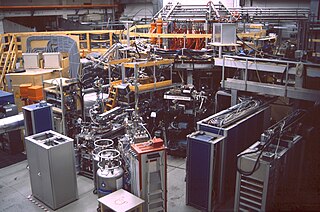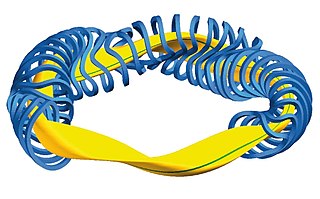Related Research Articles

In plasma physics, plasma stability concerns the stability properties of a plasma in equilibrium and its behavior under small perturbations. The stability of the system determines if the perturbations will grow, oscillate, or be damped out. It is an important consideration in topics such as nuclear fusion and astrophysical plasma.
The Hannes Alfvén Prize is a prize established by the European Physical Society (EPS) Plasma Physics Division in 2000. The Prize is awarded annually by the European Physical Society at the EPS Conference on Plasma Physics for outstanding work in the field of plasma physics: "for achievements which have shaped the plasma physics field or are expected to do so in future."

Liu Chen is an American theoretical physicist who has made original contributions to many aspects of plasma physics. He is known for the discoveries of kinetic Alfven waves, toroidal Alfven eigenmodes, and energetic particle modes; the theories of geomagnetic pulsations, Alfven wave heating, and fishbone oscillations, and the first formulation of nonlinear gyrokinetic equations. Chen retired from University of California, Irvine (UCI) in 2012, assuming the title professor emeritus of physics and astronomy.
John Bryan Taylor is a British physicist known for his contributions to plasma physics and their application in the field of fusion energy. Notable among these is the development of the "Taylor state", describing a minimum-energy configuration that conserves magnetic helicity. Another development was his work on the ballooning transformation, which describes the motion of plasma in toroidal (donut) configurations, which are used in the fusion field. Taylor has also made contributions to the theory of the Earth's Dynamo, including the Taylor constraint.
The ballooning instability is a type of internal pressure-driven plasma instability usually seen in tokamak fusion power reactors or in space plasmas. It is important in fusion research as it determines a set of criteria for the maximum achievable plasma beta. The name refers to the shape and action of the instability, which acts like the elongations formed in a long balloon when it is squeezed. In literature, the structure of these elongations are commonly referred to as 'fingers'.

Sir Steven Charles Cowley is a British theoretical physicist and international authority on nuclear fusion and astrophysical plasmas. He has served as director of the United States Department of Energy (DOE) Princeton Plasma Physics Laboratory (PPPL) since 1 July 2018. Previously he served as president of Corpus Christi College, Oxford, since October 2016. and head of the EURATOM / CCFE Fusion Association and chief executive officer of the United Kingdom Atomic Energy Authority (UKAEA).
Jose A. Boedo is a Spanish plasma physicist and a researcher at University of California, San Diego. He was elected as a fellow of the American Physical Society in 2016 for "his ground-breaking contributions to the studies of plasma drifts and intermittent plasma transport in the peripheral region of tokamaks".
Hartmut Zohm is a German plasma physicist who is known for his work on the ASDEX Upgrade machine. He received the 2014 John Dawson Award and the 2016 Hannes Alfvén Prize for successfully demonstrating that neoclassical tearing modes in tokamaks can be stabilized by electron cyclotron resonance heating, which is an important design consideration for pushing the performance limit of the ITER.

Akira Hasegawa is a Japanese theoretical physicist and engineer who has worked in the U.S. and Japan. He is known for his work in the derivation of the Hasegawa–Mima equation, which describes fundamental plasma turbulence and the consequent generation of zonal flow that controls plasma diffusion. Hasegawa also made the discovery of optical solitons in glass fibers, a concept that is essential for high speed optical communications.
Dmitri Dmitriyevich Ryutov is a Russian theoretical plasma physicist.
Keith Howard Burrell is an American plasma physicist.
Jürgen Meyer-ter-Vehn is a German theoretical physicist who specializes in laser-plasma interactions at the Max Planck Institute for Quantum Optics. He published under the name Meyer until 1973.
Kunioki Mima is a Japanese plasma physicist. He is known for his contributions to the theory of turbulent transport in plasmas, and in particular the derivation of the Hasegawa–Mima equation in 1977, which won him the 2011 Hannes Alfvén Prize.
Patrick Mora is a French theoretical plasma physicist who specializes in laser-plasma interactions. He was awarded the 2014 Hannes Alfvén Prize and 2019 Edward Teller Award for his contributions to the field of laser-plasma physics.
Friedrich E. Wagner is a German physicist and emeritus professor who specializes in plasma physics. He was known to have discovered the high-confinement mode of magnetic confinement in fusion plasmas while working at the ASDEX tokamak in 1982. For this discovery and his subsequent contributions to fusion research, was awarded the John Dawson Award in 1987, the Hannes Alfvén Prize in 2007 and the Stern–Gerlach Medal in 2009.
Thomas W. L. "Tom" Sanford is an American plasma physicist who developed a multi-wire array for use in a pulsed Z-pinch plasma system which resulted in a breakthrough for inertial confinement fusion (ICF) research. In 2005, he was awarded the Hannes Alfvén Prize with Malcolm Haines and Valentin Smirnov for his contributions to the field.

Wendelstein 7-AS was an experimental stellarator which was in operation from 1988 to 2002 by the Max Planck Institute for Plasma Physics (IPP) in Garching. It was the first of a new class of advanced stellarators with modular coils, designed with the goal of developing a nuclear fusion reactor to generate electricity.
John 'Jack' Connor is a British theoretical physicist whose research focussed on understanding the physics of nuclear fusion.

Omnigeneity is a property of a magnetic field inside a magnetic confinement fusion reactor. Such a magnetic field is called omnigenous if the path a single particle takes does not drift radially inwards or outwards on average. A particle is then confined to stay on a flux surface. All tokamaks are exactly omnigenous by virtue of their axisymmetry, and conversely an unoptimized stellarator is generally not omnigenous.

In magnetic confinement fusion, a flux surface is a surface on which magnetic field lines lie. Since the magnetic field is divergence-free, the Poincare-Hopf theorem implies that such a surface must be either a torus, or a knot. In the tokamak and the stellarator flux surfaces have toroidal shapes, whereas the more exotic knotatron has a knotted flux surface. Flux surfaces are typically characterized by the poloidal magnetic flux or the toroidal magnetic flux. The poloidal flux is the magnetic flux passing through a ribbon going from the magnetic axis to the flux surface, and the toroidal flux is the magnetic flux passing through a circle which encloses the magnetic axis. The total flux passing through flux surface itself is zero, as magnetic field lines are everywhere tangent to the surface.
References
- 1 2 "Patrick H. Diamond — UC San Diego Fusion and Astrophysical Plasma Physics Group". fapp.ucsd.edu. Retrieved June 5, 2020.
- ↑ "UC San Diego | Professor Patrick Diamond named Director of New Fusion Theory Institute - Daejeon, Korea". physics.ucsd.edu. Retrieved June 5, 2020.
- 1 2 Stroth, U; Hidalgo, C (2011). "38th European Physical Society Conference on Plasma Physics". Plasma Physics and Controlled Fusion. 53 (12): 120201. doi: 10.1088/0741-3335/53/12/120201 . ISSN 0741-3335. S2CID 250854312.
- ↑ "UC San Diego | Patrick Diamond shares Hannes Alfvén Prize". physics.ucsd.edu. Retrieved June 5, 2020.
- ↑ Vishniac, Ethan T.; Jin, Liping; Diamond, P. H. (1991). "Dynamos and angular momentum transport in accretion disks". Physics of Fluids B: Plasma Physics. 3 (8): 2374–2378. Bibcode:1991PhFlB...3.2374V. doi:10.1063/1.859606. ISSN 0899-8221.
- ↑ Diamond, Patrick Henry (1979). "Theory of Phase Space Density Granulation in Magnetoplasma". PHDT. Bibcode:1979PhDT........63D.
- ↑ "APS Fellow Archive". www.aps.org. Retrieved June 5, 2020.